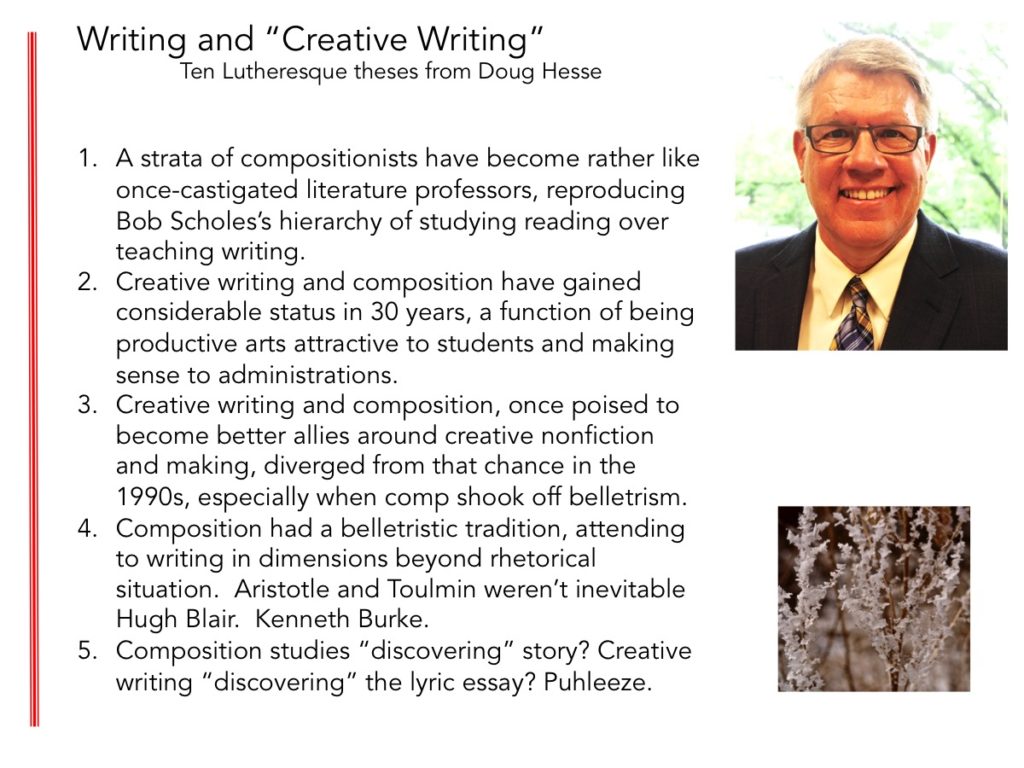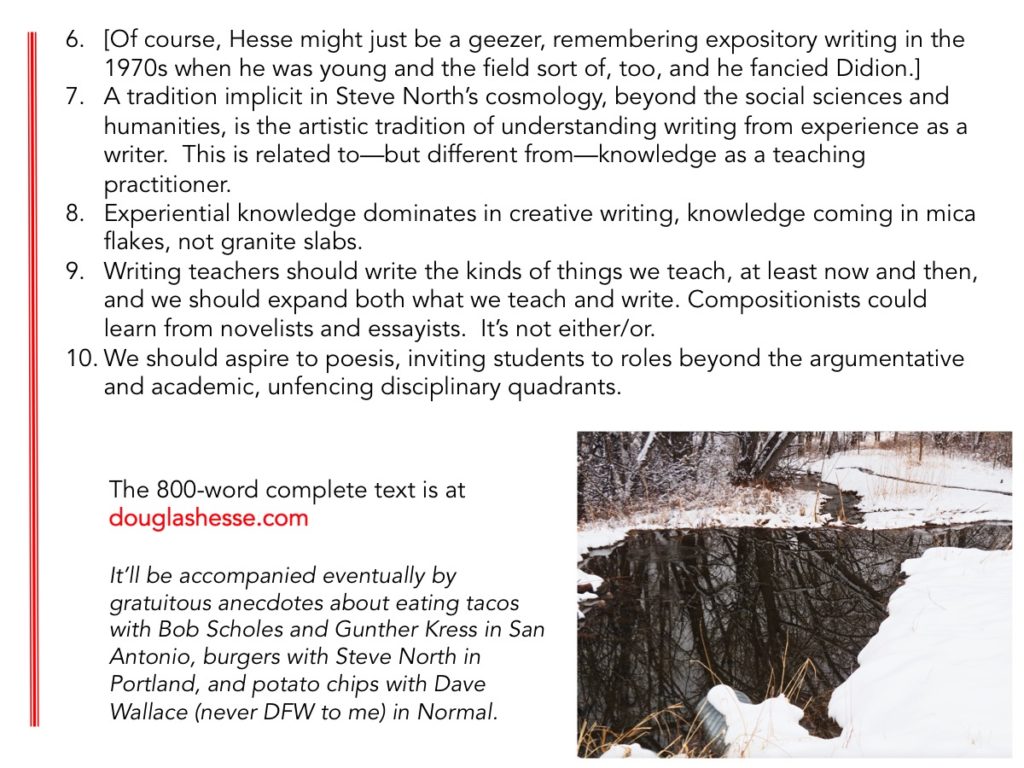I was delighted to be asked to speak on a plenary panel at MLA (the Modern Language Association) in New York, January 5, 2018, with an august group including Jonathan Alexander, Kris Blair, Doug Eyman, Deborah Holdstein, Shirley Logan, Andrea Lunsford, John Schilb, and Kathleen Blake Yancey, chaired by Suzanne Blum Malley and arranged by Cheryl Ball. 10:15 am, Hilton Murray Hill East. We were each asked to speak for 5 minutes or so, leaving extensive time for conversation, roundtable-fashion. Following are my remarks, posted here because a January storm, threatening bombogenesis (!), compelled United to cancel flight 596, leaving me adrift of NYC. Following the talk are my two powerpoint slides. –Doug, 1/3/18
With five minutes and 800 words, I’m going to proceed Martin Luther-like, not nailing 95 theses to a Wittenberg church, but rather thumbtacking ten to a Hilton podium.
- Certain strata of composition professors are becoming rather like the literature professors we castigated of yore, focusing more on studying about writing and less on teaching writing per se, more on directing how others teach in FYC or WAC or whatever. Thirty years ago, Bob Scholes sketched Cartesian coordinates for English studies. The X axis charted texts. The Y charted activities. Scholes’ axes made four hierarchized quadrants: reading literature, reading nonliterature, writing literature (aka creative writing) and writing nonliterature (aka composition). The last Scholes waggishly called writing pseudo non literature. It was a hierarchy he regretted and sought to change.
- Since then, creative writing and composition have both ascended, even triumphed. Production has gained favor for students who increasingly want to make, not consume, perceiving careers, skills, or interests in writing that they don’t in reading. My program’s Minor in Writing Practices requires a couple theory courses and several applied in writing, creative writing, journalism, and so on. We have triple the number of students we projected. At the same time, composition’s historical commitment to pedagogy, assessment, and applied research has new campus status.
- Composition and creative writing had a chance to be better allies, but mostly they’ve traveled different roads. In the late 80s and early 90s, creative writing decided to sponsor nonfiction and literary nonfiction precisely as composition studies abjured the aesthetic and belletristic.
- Composition has suffered from a few excesses in its rise, including most famously a hyperextended fixation on formalism. But one has been a hyper-projection of “rhetorical situation.” Not every writing responds to exigency or should. Hugh Blair’s Rhetoric and Belles Lettres explores how to achieve affects with words, effects aesthetic and inventive as importantly as rhetorical and reactive. Kenneth Burke knew that sort of thing, too.
- Some colleagues in rhetoric and composition studies these days are finding something new: Narrative! Story! Puhleeze. It’s embarrassing, like Hernando DeSoto finding the American West. Story has been there all along, including before logos and academic discourse became rings to rule us all. At the same time, poets are discovering “the lyric essay.” Puhleeze. They might take a peek at Charles Lamb’s “Old China” or Virginia Woolf’s “Old Mrs. Gray” or E.B. White’s “Spring.” They might take a look at Bob Scholes and Carl Klaus’s chapter on “The Essay as Poem,” in The Elements of the Essay.
- Maybe I’m just a geezer, who studied writing in an odd time and place, the 1970s at Iowa when taking expository writing with Carl Klaus meant trying to emulate Joan Didion’s strategies (albeit with a fraction of her brain), when a textbook was Walker Gibson’s Tough, Sweet, and Stuffy.
- While Scholes was publishing Textual Power, Steve North was writing The Making of Knowledge in Composition. Steve factored composition research into several categories but two main traditions, those grounded in the social sciences, using measurement or experiment to yield coding and statistical analysis vs. those grounded in the Humanities, using description or textual analysis to yield interpretation or narrative. With practitioner lore, North invoked a third tradition, the artistic, though he focused on teacher’s experiences of “what worked” or “what was said to work,” rather than on writers’ trying to figure out and explain how they wrote.
- There is writing knowledge derived from study and writing knowledge derived from experience. Creative writing prizes the Paris Review interviews, craft essays in literary magazines, author conversations after readings, prefaces, review essays. Creative writing theory comes as embodied practice, writers reflecting on what they do and why. It’s a knowledge of particulars, flakes of mica rather than granitized slabs. In fact, when preceptivized, writer knowledge seems silly. Show, don’t tell and all of that. Of course, there is a still-fledgling field called creative writing studies, which aspires to be for creative writing what composition studies is to composition.
- Writing teachers should at least now and then write things we teach. Novelists and journalists and essayists practice that. Not so much compositionists. Oh, sure writing is multitudinous: syllabi are writing and reports are writing and grading is writing. But composition teachers should be writing commentaries and op eds, essays and articles, pieces that nonprofessors might read, profiles of people and places, popular criticism, the whole shebang. Writer teachers might build their own craft and repertory. Rhet/comp graduate students might do a fiction or poetry or creative nonfiction workshop. Of course if those compositionists who do teach writing (that is, those not in the discipline-making caste) really do want to teach academic discourse, then writing academic discourse will suffice.
- But composition studies should have a bigger vision than teaching students how to write papers for other classes. I wish we were better comingled with creative writing, jointly aspiring to poesis, to inviting students to write in landscapes less fenced into disciplinary quadrants.

